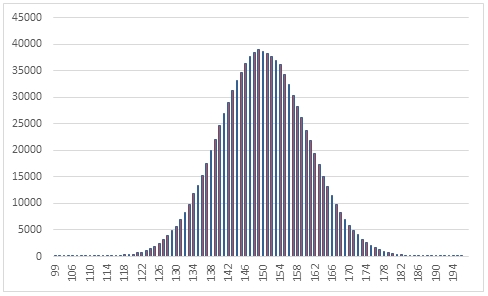SQL Server RANDBINOM Function
Updated 2023-10-18 15:33:07.660000
Description
Use the table-valued function RANDBINOM to generate a sequence of random integers from the binomial distribution for a given probability of success @p and a given number of trials @Trials.
Syntax
SELECT * FROM [westclintech].[wct].[RANDBINOM](
<@Rows, int,>
,<@p, float,>
,<@Trials, int,>)
Arguments
@Rows
the number of rows to generate. @MaxIterations must be of the type int or of a type that implicitly converts to int.
@p
the success probability in each trial. @p must be of the type float or of a type that implicitly converts to float.
@Trials
the number of trials. @Trials must be of the type int or of a type that implicitly converts to int.
Return Type
table
{"columns": [{"field": "colName", "headerName": "Name", "header": "name"}, {"field": "colDatatype", "headerName": "Type", "header": "type"}, {"field": "colDesc", "headerName": "Description", "header": "description", "minWidth": 1000}], "rows": [{"id": "8e9a1f14-0deb-417c-85d5-1f087bf1e576", "colName": "Seq", "colDatatype": "int", "colDesc": "A monotonically increasing sequence number"}, {"id": "2def7bb4-fbf8-443a-8600-6017139d8b3e", "colName": "X", "colDatatype": "float", "colDesc": "The random variable"}]}
Remarks
@p must be greater than or equal to zero and less than or equal to 1 (0 <= @p <= 1).
@Trials must be greater than zero.
If @p is NULL then @p is set to 0.
If @Trials is NULL then @Trials is set to 1.
If @Rows is less than 1 then no rows are returned.
Examples
In this example we create a sequence 1,000,000 random numbers from a binomial distribution with @p = 0.3 and @Trials = 500, COUNT the results, paste then into Excel and graph them.
SELECT X,
COUNT(*) as [COUNT]
FROM
(
SELECT X
FROM wct.RANDBINOM( 1000000, --@Rows
0.3, --@p
500 --@Trials
)
) n
GROUP BY X
ORDER BY 1;
This produces the following result.

In this example we generate 1,000,000 random numbers from a binomial distribution with probability of .70 and number of trials = 140. We calculate the mean, standard deviation, skewness, and excess kurtosis from the resultant table and compare those values to the expected values for the distribution.
DECLARE @size as int = 1000000;
DECLARE @p as float = 0.70;
DECLARE @trials as float = 140;
DECLARE @mean as float = @p*@trials;
DECLARE @var as float = @mean*(1e+00-@p);
DECLARE @stdev as float = SQRT(@var);
DECLARE @skew as float =(1 - 2*@p)/@stdev;
DECLARE @kurt as float =(1-6*@p*(1e+00-@p))/@var;
SELECT
stat,
[RANDBINOM],
[EXPECTED]
FROM (
SELECT
x.*
FROM (
SELECT
AVG(cast(x as float)) as mean_BINOM,
STDEVP(x) as stdev_BINOM,
wct.SKEWNESS_P(x) as skew_BINOM,
wct.KURTOSIS_P(x) as kurt_BINOM
FROM
wct.RANDBINOM(@size,@p,@trials)
)n
CROSS APPLY(
VALUES
('RANDBINOM','avg', mean_BINOM),
('RANDBINOM','stdev', stdev_BINOM),
('RANDBINOM','skew', skew_BINOM),
('RANDBINOM','kurt', kurt_BINOM),
('EXPECTED','avg',@mean),
('EXPECTED','stdev',@stdev),
('EXPECTED','skew',@skew),
('EXPECTED','kurt',@kurt)
)x(fn_name,stat,val_stat)
)d
PIVOT(sum(val_stat) FOR fn_name in([RANDBINOM],[EXPECTED])) P;
This produces the following result (your result will be different).
{"columns":[{"field":"stat"},{"field":"RANDBINOM","headerClass":"ag-right-aligned-header","cellClass":"ag-right-aligned-cell"},{"field":"EXPECTED","headerClass":"ag-right-aligned-header","cellClass":"ag-right-aligned-cell"}],"rows":[{"stat":"avg","RANDBINOM":"97.989814","EXPECTED":"98"},{"stat":"kurt","RANDBINOM":"-0.00503179349084126","EXPECTED":"-0.00884353741496599"},{"stat":"skew","RANDBINOM":"-0.0764751418091853","EXPECTED":"-0.0737711113563317"},{"stat":"stdev","RANDBINOM":"5.422481742284","EXPECTED":"5.42217668469038"}]}
See Also
BINOMINV - Inverse (quantile) of the binomial distribution
RANDBETA - Random numbers from a beta distribution
RANDCAUCHY - Random numbers from a Cauchy distribution
RANDCHISQ - Random numbers from a chi-squared distribution
RANDEXP - Random numbers from an exponential distribution
RANDFDIST - Random numbers from an F-distribution
RANDGAMMA - Random numbers from a gamma distribution
RANDLAPLACE - Random numbers from a LaPlace distribution
RANDLOGISTIC - Random numbers from a logistic distribution
RANDNORMAL - Random numbers from the normal distribution
RANDPOISSON - Random numbers from a Poisson distribution
RANDSNORMAL - Random numbers from the standard normal distribution